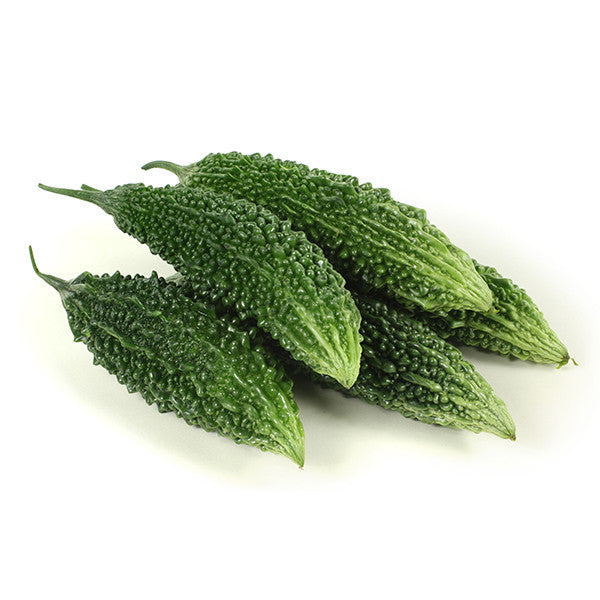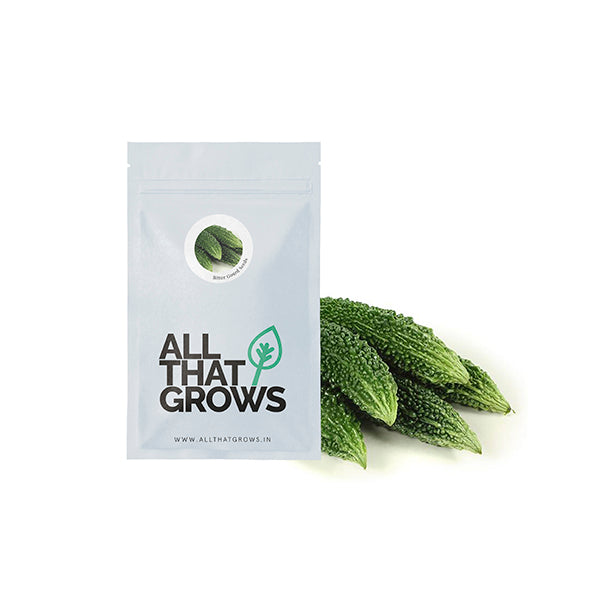



- SOWING
TIMESummer & rainy season
- Sowing
DistanceSeed to seed - 1'
Line to line - 4' - Fruit
Weight50-75 gms
- Fruit
Shape7"-8" long
- Days to
maturity55-60 days after sowing
- Details
- How to sow
- Reviews
Karela, as better known in India and some neighboring countries, is also called by names such as bitter melon, bitter gourd, bitter squash and balsam pear. Bitter Gourd comes packed with nutrients that enable you to lead a healthy life. Most important of all is a phytonutrient Polypeptide-P, which is a plant insulin that lowers blood sugar levels naturally. Not just this, it also has the potential to treat cancer and HIV infection in their early stages. It also carries a potent dose of Vitamin C, A, K and is proven to work wonders for the skin and liver.
Bitter Gourd is also helpful in lowering cholesterol, removing the kidney stones, and even reducing the risk of pancreatic cancer.
As far as the taste is concerned, rubbing salt or soaking peeled bitter gourd in salt water prior to cooking, cuts down on the bitterness considerably. Either cut it in fine rings and cook it like other vegetables with spices or simply slit through and stuff it with your favorite spices for an interesting dish.
Planting instructions
Sow seeds in holes about a half - inch deep (1.25 cm) and spaced 12 inches (30 cm) apart. Sow two seeds in each hole.
Seeds germinate in 8 to 10 days, though it is sensitive to temperature changes.
Add a rope to support the young plant.
Prune away the growing tip when it reaches the top of the trellis. As a result, the plant will produce a greater number of flowers and fruit sooner.
Growing Requirements
watering
Water regularly to keep the soil moist, but not soggy.
pests
Pests first appear as white powdery residue primarily on the upper leaf surface. On the lower surface of the leaves, circular patches or spots appear. In severe cases, these spread, coalesce and cover both the surfaces of the leaves and spread also to the petioles, stem, etc. Some of the types attacking are fungal diseases like powdery mildew and downy mildew, watermelon mosaic virus, rots, fruit flies etc.
soil
Bitter gourd grows best in organically rich, sandy or loamy soil that drains well. A well drained soil with a pH ranging between 6.5-7.5, enriched with organic matter, such as compost or dried manure.
spot
Select a warm, sunny planting location. Provide full sun to this vine; at least 6 hours of sunlight.
temperature
Seeds require the temperature above 70°F (20°C) for germination.
how to harvest
To make bittergourd seeds, simply allow a fruit on the vine and let it mature. When the seed is fully mature, it will alter its colour to yellow and open to reveal the sources.
You can cut the produce from the vine and open the fruit to get the germs away.
Wash the seeds and place them on a paper towel to soak up. Dry in shade and storage in an airtight bag.

Customer Reviews
The productiveness of any seed we sell is subject to your local climatic conditions*, the sowing method you adopt, and your commitment to the planting process. We give no warranty, expressed or implied, and are in no way responsible for the produce.
Please note that all our seasonal recommendations/ sowing information is as per the local climatic conditions. *For more information on the optimum conditions required for growing seeds in your region, please contact us at, hello@allthatgrows.in or Whatsapp us at, +91 8544865077
Questions & Answers
Ask a Question-
Do you have white variety of bitter gourd seeds?
Hi,
Thanks for reaching out to us.
We do have Bitter gourd white seeds availble with us.
You can check out on this link https://www.allthatgrows.in/products/bitter-gourd?_pos=1&_sid=e288c3e93&_ss=r
Let us know in case of any other query.
Thank you




Bitter Gourd Seeds
Seed Type : Non-Hybrid, Open Pollinated and Non-GMO
Plant : Vigorous vines, hard stems
Sowing time : Summer as well as rainy season
Fruit : Dark green with spines, sleek
Fruit length : 7-8 inches long
First Picking : After 55-60 days from sowing
Karela, as better known in India and some neighboring countries, is also called by names such as bitter melon, bitter gourd, bitter squash and balsam pear. Bitter Gourd comes packed with nutrients that enable you to lead a healthy life. Most important of all is a phytonutrient Polypeptide-P, which is a plant insulin that lowers blood sugar levels naturally. Not just this, it also has the potential to treat cancer and HIV infection in their early stages. It also carries a potent dose of Vitamin C, A, K and is proven to work wonders for the skin and liver.
Bitter Gourd is also helpful in lowering cholesterol, removing the kidney stones, and even reducing the risk of pancreatic cancer.
As far as the taste is concerned, rubbing salt or soaking peeled bitter gourd in salt water prior to cooking, cuts down on the bitterness considerably. Either cut it in fine rings and cook it like other vegetables with spices or simply slit through and stuff it with your favorite spices for an interesting dish.
Seed Type : Non-Hybrid, Open Pollinated and Non-GMO
Plant : Vigorous vines, hard stems
Sowing time : Summer as well as rainy season
Fruit : Dark green with spines, sleek
Fruit length : 7-8 inches long
First Picking : After 55-60 days from sowing
- SOWING
TIMESummer & rainy season
- Sowing
DistanceSeed to seed - 1'
Line to line - 4' - Fruit
Weight50-75 gms
- Fruit
Shape7"-8" long
- Days to
maturity55-60 days after sowing
Planting instructions
Sow seeds in holes about a half - inch deep (1.25 cm) and spaced 12 inches (30 cm) apart. Sow two seeds in each hole.
Seeds germinate in 8 to 10 days, though it is sensitive to temperature changes.
Add a rope to support the young plant.
Prune away the growing tip when it reaches the top of the trellis. As a result, the plant will produce a greater number of flowers and fruit sooner.
Growing Requirements
watering
Water regularly to keep the soil moist, but not soggy.
pests
Pests first appear as white powdery residue primarily on the upper leaf surface. On the lower surface of the leaves, circular patches or spots appear. In severe cases, these spread, coalesce and cover both the surfaces of the leaves and spread also to the petioles, stem, etc. Some of the types attacking are fungal diseases like powdery mildew and downy mildew, watermelon mosaic virus, rots, fruit flies etc.
soil
Bitter gourd grows best in organically rich, sandy or loamy soil that drains well. A well drained soil with a pH ranging between 6.5-7.5, enriched with organic matter, such as compost or dried manure.
spot
Select a warm, sunny planting location. Provide full sun to this vine; at least 6 hours of sunlight.
temperature
Seeds require the temperature above 70°F (20°C) for germination.
how to harvest
To make bittergourd seeds, simply allow a fruit on the vine and let it mature. When the seed is fully mature, it will alter its colour to yellow and open to reveal the sources.
You can cut the produce from the vine and open the fruit to get the germs away.
Wash the seeds and place them on a paper towel to soak up. Dry in shade and storage in an airtight bag.



 Sign In
Sign In








